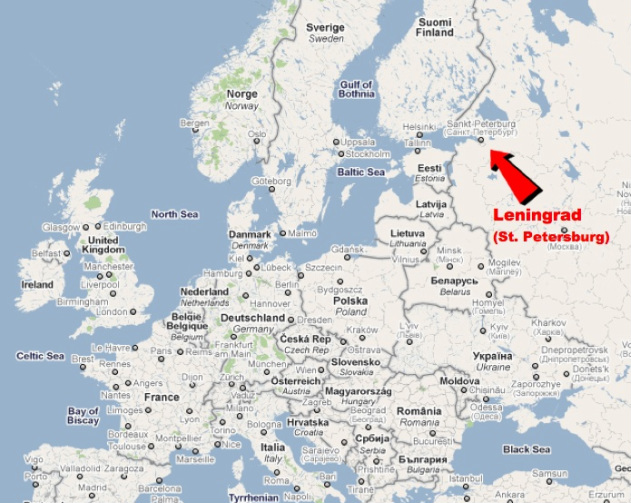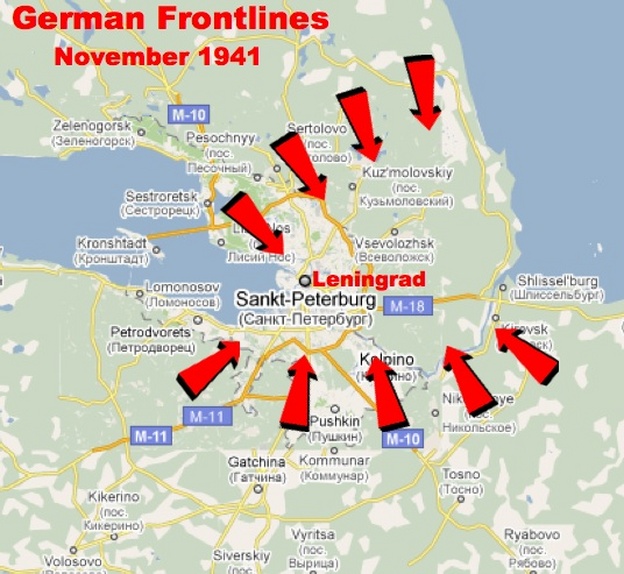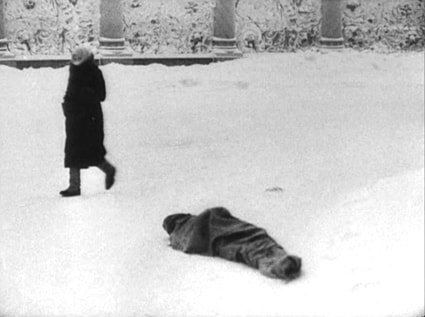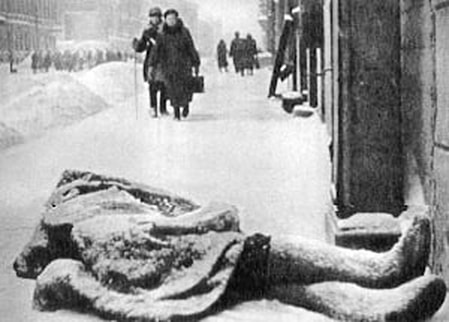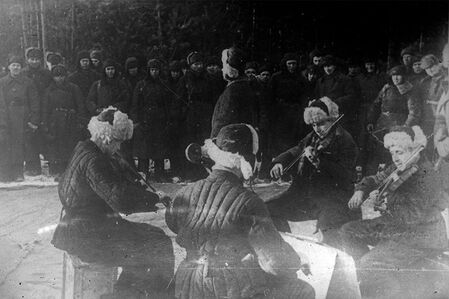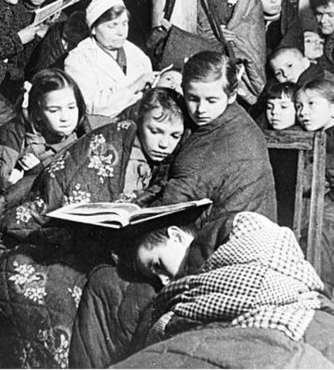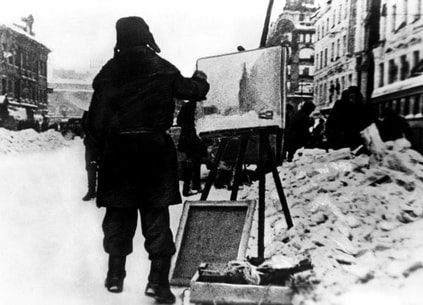Historical Context of the Siege of Leningrad
Preparing for the Invasion
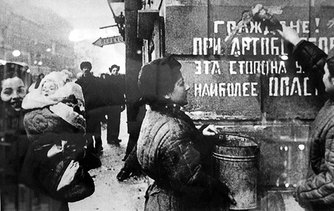
As the German front lines moved closer the children of Leningrad were sent out into the streets with buckets of whitewash. They were told to paint over the street signs. It was decided that when the Germans invaded the city they would get no help finding their way around!
Anti-tank Barriers
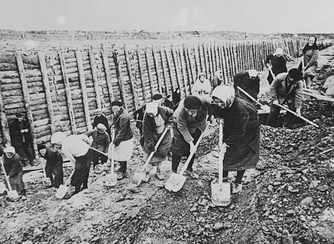
Large metal anti-tank "hedgehogs" were placed around the perimeter of the city to stop the German tanks. With most of the men at the front it was left to the women of Leningrad to dig trenches around the city that also acted as anti-tank barriers.
The women and elderly armed themselves and learned how to use weapons. They had anti-tank barriers, trenches, whitewashed signs and armed citizens. The city was ready for the invasion.
The women and elderly armed themselves and learned how to use weapons. They had anti-tank barriers, trenches, whitewashed signs and armed citizens. The city was ready for the invasion.
But the invasion never came. Hitler had something much more cruel in mind.
Leningrad's Vulnerable Position
Leningrad is on a narrow strip of land and surrounded on two sides by bodies of water. When the German front lines moved in from the north and south it was very easy to blockade the city. This is what Hitler did in the fall of 1941. Rather than invade the city he simply blockaded it and waited for the millions of inhabitants to starve or freeze to death. He knew they had a 30 day supply of food, and decided to wait the month out. He had a much longer wait than he ever imagined.
Winter Arrives
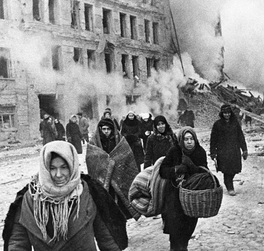
In the first brutal winter of the blockade life in Leningrad was grim. It was an unusually cold winter, even by Russian standards. Fuel quickly ran out. The food supply ran out. No clean water. And the Germans continued to bomb the city.
No food. No heat. No clean water. For 900 days.
Food Rations
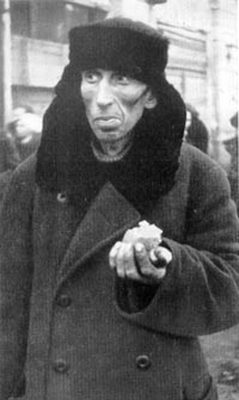
In January 1942 in the depths of an unusually cold winter, the city's food rations reached an all time low of only 125 grams (about 1/4 of a pound) of bread per person per day. With very little flour left in reserve, sawdust was added to the coarse black bread.
Nutritionists estimate a manual worker needs approximately 3000 calories a day. On their bread ration citizens were receiving only 500 calories a day.
It was rumored that books were held together with paste made from potato flour. Libraries were pillaged, the books stripped of their paste. Wallpaper was also said to have potato paste in the glue. People stripped it off their walls and ate it to help stay alive. Leather shoes and briefcases were boiled and eaten.
At one time the city had a plentiful pigeon population but they were quickly eaten. Rats and mice were the next to be eaten. In heartbreaking desperation, the citizens of Leningrad next had to eat their household pets. And after there were no more pets in the city, the Leningraders survival instincts overpowered them...one would notice that fresh corpses would be missing chunks of flesh. And soon there were rumors of young children disappearing, victims of cannibalism.
Nutritionists estimate a manual worker needs approximately 3000 calories a day. On their bread ration citizens were receiving only 500 calories a day.
It was rumored that books were held together with paste made from potato flour. Libraries were pillaged, the books stripped of their paste. Wallpaper was also said to have potato paste in the glue. People stripped it off their walls and ate it to help stay alive. Leather shoes and briefcases were boiled and eaten.
At one time the city had a plentiful pigeon population but they were quickly eaten. Rats and mice were the next to be eaten. In heartbreaking desperation, the citizens of Leningrad next had to eat their household pets. And after there were no more pets in the city, the Leningraders survival instincts overpowered them...one would notice that fresh corpses would be missing chunks of flesh. And soon there were rumors of young children disappearing, victims of cannibalism.
City of Sleds
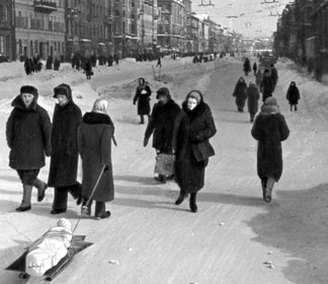
In the first winter of the siege many people froze to death. The bodies of loved ones were wrapped up and taken the cemeteries. The ground was frozen solid, much too hard to dig any graves so the bodies were simply piled up outside the cemetery gates.
Children's sleds became a common conveyance to carry the dead to their final resting places. It was an all too familiar site to see a child's sled carrying gruesome cargo.
But often times the bodies were left were they fell. The citizens of Leningrad were too weak from hunger to move them. It was not uncommon to see people simply step over the bodies.
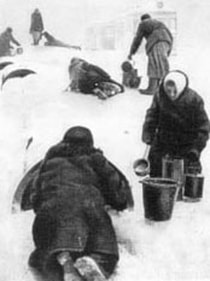
Dirty water had to be pulled from holes in the ice in the river.
The Radio House Offers Hope
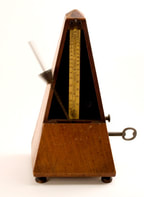
Russians deeply love their art, music and literature and the workers at the Radio House used this in order to keep up the morale of the besieged city. Though radio silence was in effect the citizens of Leningrad would not live without their beloved music and poetry. The Radio House workers strung P.A. speakers throughout the city and played music, read poetry or literature over the speakers 24 hours a day. Hitler could take their food, their heat, their clean water, but he could never take their art! It was their saving grace, their last glimmer of hope.
Despite extreme weakness from hunger the Radio House workers kept the “broadcasts” going 24 hours a day.
At times the workers were so weak all they could manage to do was to set a metronome in front of the microphone and let the click, click, click resonate throughout the city. It became the heartbeat of the city. They would never allow the Radio House to lapse into silence. Silence meant defeat. Silence meant death.
Despite extreme weakness from hunger the Radio House workers kept the “broadcasts” going 24 hours a day.
At times the workers were so weak all they could manage to do was to set a metronome in front of the microphone and let the click, click, click resonate throughout the city. It became the heartbeat of the city. They would never allow the Radio House to lapse into silence. Silence meant defeat. Silence meant death.
The Road of Life
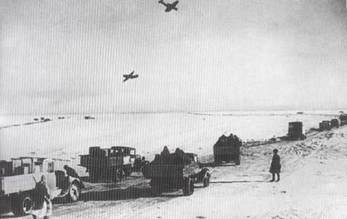
If the temperatures drop enough, ice will form on Lake Ladoga and if it gets thick enough, Leningraders can cross the lake to the other side, which is not yet occupied by Germans. It's a dangerous route. Once the ice road over the frozen lake reached the far shore meager supplies were able to enter the city, and citizens could be evacuated. However, with so many starving and only so much that could be brought into the city it eased the suffering only minimally. But it definitely helped. Morale was greatly increased when the road reached the far side of the lake.
"Our music, art and literature will save us."
Leningraders took great comfort in their Russian poetry, art, music and literature. Despite unbelievably horrific conditions, they always took time and effort to connect with their deep love of the arts.
Musicians would play in the freezing streets...
Musicians would play in the freezing streets...
Everyone kept their favorite book of poetry at hand...
Painters found a harsh beauty in the bombed streets...
Even Hitler's cruel blockade could not crush their poetic souls.
The Blockade is Broken
In the end the Germans NEVER entered the city. It is estimated that half of the city's three million citizens died, but the blockade was eventually broken. The city was saved. The siege lasted 900 days, but the Leningraders never gave up. One survivor said "If you make nails of these people there will be no harder nails in the world."
"Let no one forget, let nothing be forgotten." -- Olga Berggolts
Go to the download page to get the complete script, treatment or deck.
Go back to the main Happy Frog Films website.
Go back to the main Happy Frog Films website.
